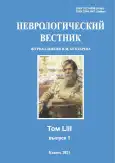Error-related negativity: neurocognitive transdiagnostic marker of anxiety disorders
- Authors: Sagalakova O.A.1, Truevtsev D.V.1, Zhirnova O.V.1
-
Affiliations:
- Altai State University
- Issue: Vol LIII, No 1 (2021)
- Pages: 80-83
- Section: Brief communications
- Submitted: 20.01.2021
- Accepted: 01.02.2021
- Published: 20.04.2021
- URL: https://journals.eco-vector.com/1027-4898/article/view/58800
- DOI: https://doi.org/10.17816/nb58800
- ID: 58800
Cite item
Abstract
The article is devoted to the analysis of the prospects for research on neurocognitive mechanisms of anxiety disorders. In response to limitations and contradictions in the logic of the categorical method of classification of mental disorders, the popularity of the dimensional approach, in which the emphasis shifts to the assessment of the severity of symptoms. The National Institute of Mental Health has developed the promising approach based on the search for systemic neurobiological foundations of mental disorders. Based on the project RDoC (Research Domain Criteria) the search for trans-diagnostic mechanisms of mental disorders has been updated. The logic of RDoC echoes the position of Russian pathopsychology, in which the syndrome of mental activity disorders is considered in dynamics, the mechanisms of the functioning of the psyche are qualified as identical in norm and pathology. In the study of anxiety-related disorders, the obvious commonality of the spectrum of manifestations that acquire nosological clarification against the background of the escalation of the severity of symptoms and secondary compensatory processes has repeatedly been put forward in the center of research attention. The aim of the article is a theoretical and methodological analysis of the neurocognitive basis of the errors monitoring system, characteristic of normal and excessively expressed in anxiety disorders, including ERP component — error related negativity (ERN). As a result, it is shown that this neurocogitive marker, experimentally modeled in conflict tasks (e.g., Eriksen’s flanker task), is expected to be a probable transdiagnostic basis for anxiety-related disorders (social anxiety disorder, obsessive-compulsive disorder). The increase in the amplitude of ERN in internalization, uniting anxiety-depressive symptoms, is explained by individual differences in the readiness to detect error and sensitivity to incorrect decisions. At the moment, the study of ERN retains the “tempted” of simplified interpretations, the arbitrary establishment of direct causal connections between the neural basis and mental phenomena.
Full Text
About the authors
Olga A. Sagalakova
Altai State University
Author for correspondence.
Email: olgasagalakova@mail.ru
ORCID iD: 0000-0001-9975-1952
SPIN-code: 4455-7179
Scopus Author ID: 57190580782
ResearcherId: U-4959-2019
PhD in Psychology, Associate Professor, Head of the Educational Specialized Laboratory of Experimental Medical Psychology, Associate Professor, Clinical Psychology Department, Institute of Psychology
Russian Federation, 656049, Barnaul, Lenin str., 61Dmitry V. Truevtsev
Altai State University
Email: truevtsev@gmail.com
ORCID iD: 0000-0003-4246-2759
SPIN-code: 2983-0984
Scopus Author ID: 57190579221
ResearcherId: U-4998-2019
PhD in Psychology, Head of the Clinical Psychology Department, Institute of Psychology
Russian Federation, 656049, Barnaul, Lenin str., 61Olga V. Zhirnova
Altai State University
Email: olga.zhirnova.2015@mail.ru
ORCID iD: 0000-0002-6680-8286
SPIN-code: 6870-8526
Student
Russian Federation, 656049, Barnaul, Lenin str., 61References
- Clark L.A., Watson D., Reynolds S. Diagnosis and classification of psychopathology: challenges to the current system and future directions. Annu. Rev. Psychol. 1995; 46 (1): 121–153. doi: 10.1146/annurev.ps.46.020195.001005.
- Krueger R.F., Eaton N.R. Transdiagnostic factors of mental disorders. World Psychiatry. 2015; 14 (1): 27–29. doi: 10.1002/wps.20175.
- Wakefield J.C. The perils of dimensionalization: challenges in distinguishing negative traits from personality disorders. Psychiatr. Clin. N. Am. 2008; 31 (3): 379–393. doi: 10.1016/j.psc.2008.03.009.
- Gehring W.J., Goss B., Coles M.G.H. et al. A neural system for error detection and compensation. Psychol. Sci. 1993; 4 (6): 385–390. doi: 10.1111/j.1467-9280.1993.tb00586.x.
- Сагалакова О.А., Жирнова О.В., Труевцев Д.В., Стоянова И.Я. Когнитивные факторы нарушений психической деятельности при обсессивно-компульсивном расстройстве. Сибирский психол. ж. 2020; 75: 159–181. [Sagalakova O.A., Zhirnova O.V., Truevtsev D.V., Stoyanova I.Ya. Kognitivny`e faktory` narushenij psikhicheskoj deyatel`nosti pri obsessivno-kompul`sivnom rasstrojstve. Sibirskiy psikhologicheskiy zhurnal. 2020; 75: 159–181. (In Russ.)] doi: 10.17223/17267080/75/9.
- Carrasco M., Hong C., Nienhuis J.K. et al. Increased error-related brain activity in youth with obsessive-compulsive disorder and other anxiety disorders. Neurosci. Lett. 2013; 541: 214–218. doi: 10.1016/j.neulet.2013.02.017.
- Clark D., Wells A. A cognitive model of social phobia. In: R.G. Heimberg, M.R. Liebowitz, D.A. Hope, F.R. Schneier (eds.) Social phobia: Diagnosis, assessment and treatment. New York, NY: Guilford Press. 1995; 69–93.
- Voegler R., Peterburs J., Lemke H. et al. Electrophysiological correlates of performance monitoring under social observation in patients with social anxiety disorder and healthy controls. Biol. Psychol. 2018; 132: 71–80. doi: 10.1016/j.biopsycho.2017.11.003.
- Filippi C.A., Subar A.R., Sachs J.F. et al. Developmental pathways to social anxiety and irritability: The role of the ERN. Dev. Psychopathol. 2020; 32 (3): 897–907. doi: 10.1017/s0954579419001329.
- Pasion R., Barbosa F. ERN as a transdiagnostic marker of the Internalizing-Externalizing Spectrum: a dissociable meta-analytic effect. Neurosci. Biobehav. Rev. 2019; 103: 1–17. doi: 10.1016/j.neubiorev.2019.06.013.
Supplementary files







